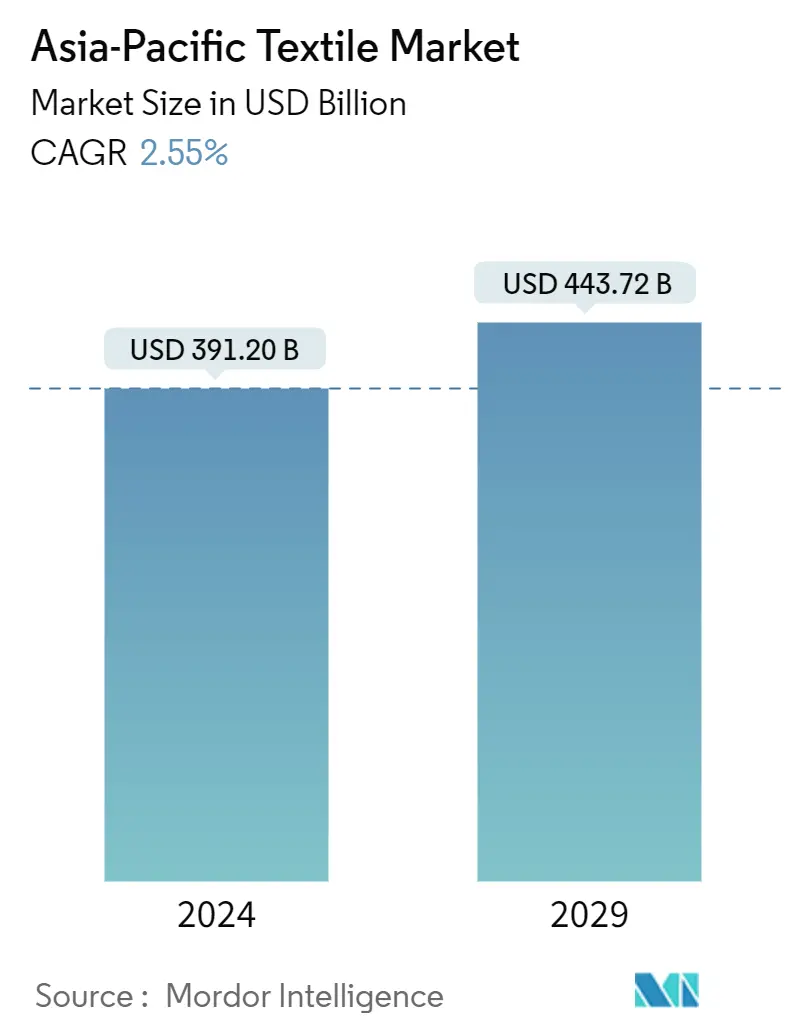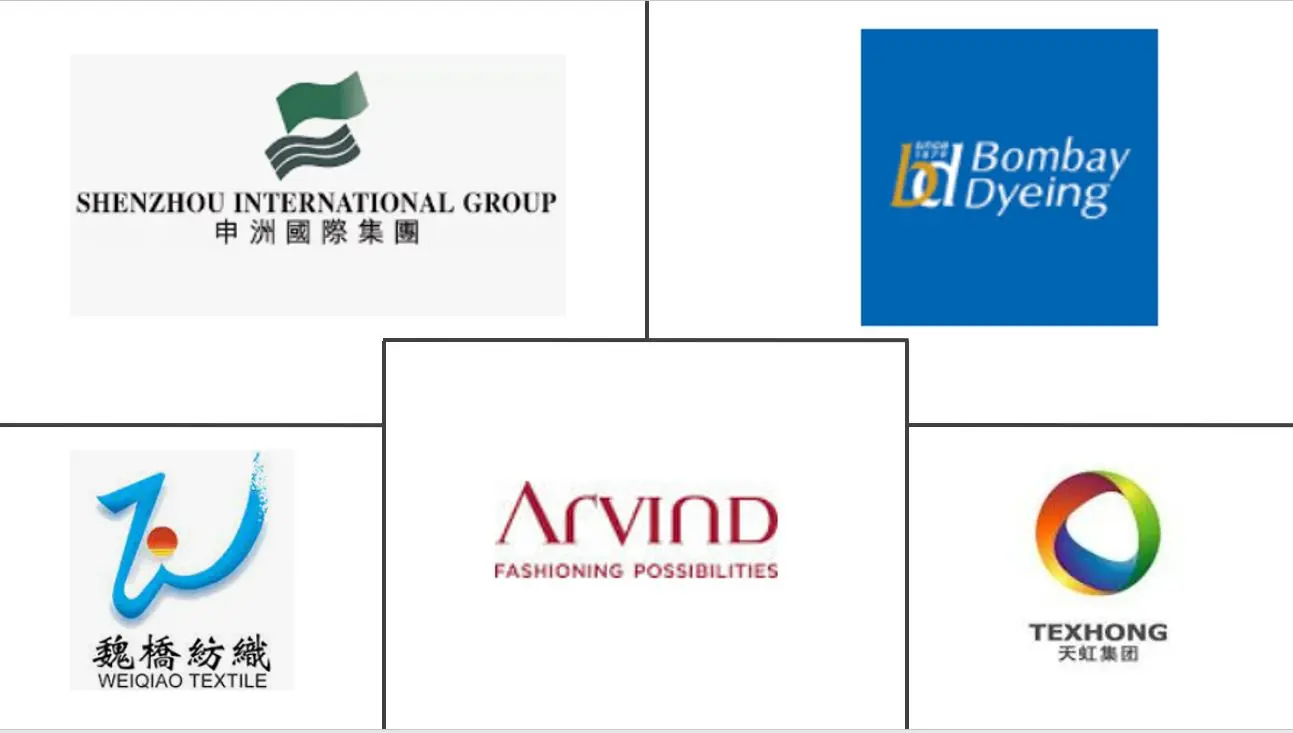Market Size of Asia-Pacific Textile Industry

| Study Period | 2020-2029 |
| Base Year For Estimation | 2023 |
| Market Size (2024) | USD 391.20 Billion |
| Market Size (2029) | USD 443.72 Billion |
| CAGR (2024 - 2029) | 2.55 % |
| Market Concentration | Low |
Major Players
*Disclaimer: Major Players sorted in no particular order |
Asia Textile Market Analysis
The Asia-Pacific Textile Market size is estimated at USD 391.20 billion in 2024, and is expected to reach USD 443.72 billion by 2029, growing at a CAGR of 2.55% during the forecast period (2024-2029).
- Increasing demand for clothing and home furnishing products in the Asia-Pacific region are the major growth factors.
- The COVID-19 crisis caused considerable damage and hardship across the global garment industry, affecting brands, manufacturers, and workers in various multitudes. The pandemic has exposed acute vulnerabilities in garment supply chains and the impact that sourcing decisions have on supplier factories and their workers. With the bulk of global garment production in Asia, the region remains the frontline of the adverse effects rippling through the supply chain.
- Asia-Pacific is both the largest and fastest-growing silk market. Due to the easy availability of raw silk, China leads the Asia-Pacific silk market, accounting for approximately 80% of the region's demand for silk. China is also the world's largest producer of raw silk and silk yarns, trailing India, Thailand, and Uzbekistan. The country is the world's leading textile exporter, accounting for roughly 40% of global textile and clothing exports. With over 20,000 enterprises. The Asia-Pacific silk market is expected to expand further as a result of the region's growing economy, rapid advances in sericulture technology, and increased use of silk in the textile industry.
- Thailand is well-known throughout the world as one of the world's largest producers of fabric, sportswear, children's wear, women's wear, and casualwear. Furthermore, the country's exquisite finishing, dyeing, and printing services make it one of the world's most popular textile outsourcing destinations. Thailand currently employs nearly one million people through its 4,500 textile and apparel manufacturers. Most of these manufacturers, based in and around Bangkok and eastern Thailand, produce everything from man-made fiber plants, spinning and weaving to dyeing and printing.
- According to Bangladesh's Export Promotion Bureau (EPB), the country's home textile export basket includes bed linen, bed sheet and other bedroom textiles, bath linen, carpets and rugs, blankets, kitchen linen, curtains, cushions and cushion covers, and quilt covers. Home textiles earned USD 1.62 billion from exports in the recently concluded fiscal year 2021-22, representing year-on-year growth of 43.28%. It is worth noting that home textiles earned USD 1.13 billion in exports in the previous fiscal year.
- With Asia accounting for the majority of global garment production, the region remains at the forefront of the negative effects reverberating through the supply chain. With the challenges comes a window of opportunity for new alliances and new thinking about the industry's future and, more importantly, how it can be reshaped for a more resilient, sustainable, and human-centered future. Domestic consumers have prompted businesses to reconsider their supply chains, and e-commerce and digitalization have benefited.
Asia Textile Industry Segmentation
The textile industry involves sections like research, design, development, manufacturing, and distribution of textiles, fabrics, and clothing. A complete background analysis of the Asia-Pacific Textile Market, including the assessment of the economy and contribution of sectors in the economy, market overview, market size estimation for key segments, and emerging trends in the market segments, market dynamics, and geographical trends, and COVID-19 impact is included in the report.
The Asia-Pacific textile market is segmented by application (clothing, industrial and technical, household, and other applications), by material (cotton, jute, silk, synthetics, and wool), and by geography (China, India, Pakistan, Bangladesh, Australia, and Rest of Asia-Pacific). The report offers market size and forecasts for the Asia-Pacific Textile Market in value (USD) for all the above segments.
| Application | |
| Clothing | |
| Industrial and Technical | |
| Household | |
| Other Applications |
| Material | |
| Cotton | |
| Jute | |
| Silk | |
| Synthetics | |
| Wool |
| Geography | |
| China | |
| India | |
| Pakistan | |
| Bangladesh | |
| Australia | |
| Rest of Asia-Pacific |
Asia-Pacific Textile Market Size Summary
The Asia-Pacific textile industry is a significant player in the global market, characterized by its vast size and dynamic growth trajectory. The region's textile sector is driven by increasing consumer demand for clothing and home furnishings, with countries like China, Thailand, and Bangladesh playing pivotal roles in production and export. China, in particular, stands out as the world's largest producer and exporter of textiles, leveraging its abundant raw materials and advanced sericulture technology. The region's textile market is also witnessing a shift towards high-value fabrics and blended fibers, catering to changing consumer preferences for affordable and comfortable clothing. This evolution is supported by the region's young population and the growing influence of digital solutions in the apparel sector.
The COVID-19 pandemic has posed challenges to the industry, exposing vulnerabilities in supply chains and prompting a reevaluation of sourcing strategies. However, these challenges have also opened avenues for innovation and resilience, encouraging companies to explore new partnerships and digitalization opportunities. The Asia-Pacific textile market remains highly competitive and fragmented, with major players like Shenzhou International Group and Weiqiao Textile leading the charge. The market's growth is further bolstered by rising consumer spending on clothing and footwear, alongside the increasing demand for home textiles. As the region continues to expand its footprint in the global textile landscape, strategic mergers, acquisitions, and technological advancements are expected to strengthen its market position.
Asia-Pacific Textile Market Size - Table of Contents
-
1. MARKET INSIGHTS AND DYNAMICS
-
1.1 Current Market Scenario
-
1.2 Market Dynamics
-
1.2.1 Drivers
-
1.2.1.1 Rising willingness to pay premium for high quality apparel
-
1.2.1.2 Shifting inclination toward natural fiber-based textile garments
-
-
1.2.2 Restraints
-
1.2.2.1 Asia pacific trade limitations because of supply chain disruption
-
-
1.2.3 Opportunities
-
1.2.3.1 Growing influence of social media and e-commerce platform
-
-
-
1.3 Value Chain / Supply Chain Analysis
-
1.4 Porter's Five Forces Analysis
-
1.4.1 Threat of New Entrants
-
1.4.2 Bargaining Power of Buyers/Consumers
-
1.4.3 Bargaining Power of Suppliers
-
1.4.4 Threat of Substitute Products
-
1.4.5 Intensity of Competitive Rivalry
-
-
1.5 Supply Chain/Value Chain Analysis
-
1.6 Technological Trends and Automation
-
1.7 Government Regulations and Initiatives
-
1.8 Insights into the E-commerce Market
-
1.9 Impact of COVID-19 on the Market
-
-
2. MARKET SEGMENTATION
-
2.1 Application
-
2.1.1 Clothing
-
2.1.2 Industrial and Technical
-
2.1.3 Household
-
2.1.4 Other Applications
-
-
2.2 Material
-
2.2.1 Cotton
-
2.2.2 Jute
-
2.2.3 Silk
-
2.2.4 Synthetics
-
2.2.5 Wool
-
-
2.3 Geography
-
2.3.1 China
-
2.3.2 India
-
2.3.3 Pakistan
-
2.3.4 Bangladesh
-
2.3.5 Australia
-
2.3.6 Rest of Asia-Pacific
-
-
Asia-Pacific Textile Market Size FAQs
How big is the Asia-Pacific Textile Market?
The Asia-Pacific Textile Market size is expected to reach USD 391.20 billion in 2024 and grow at a CAGR of 2.55% to reach USD 443.72 billion by 2029.
What is the current Asia-Pacific Textile Market size?
In 2024, the Asia-Pacific Textile Market size is expected to reach USD 391.20 billion.

